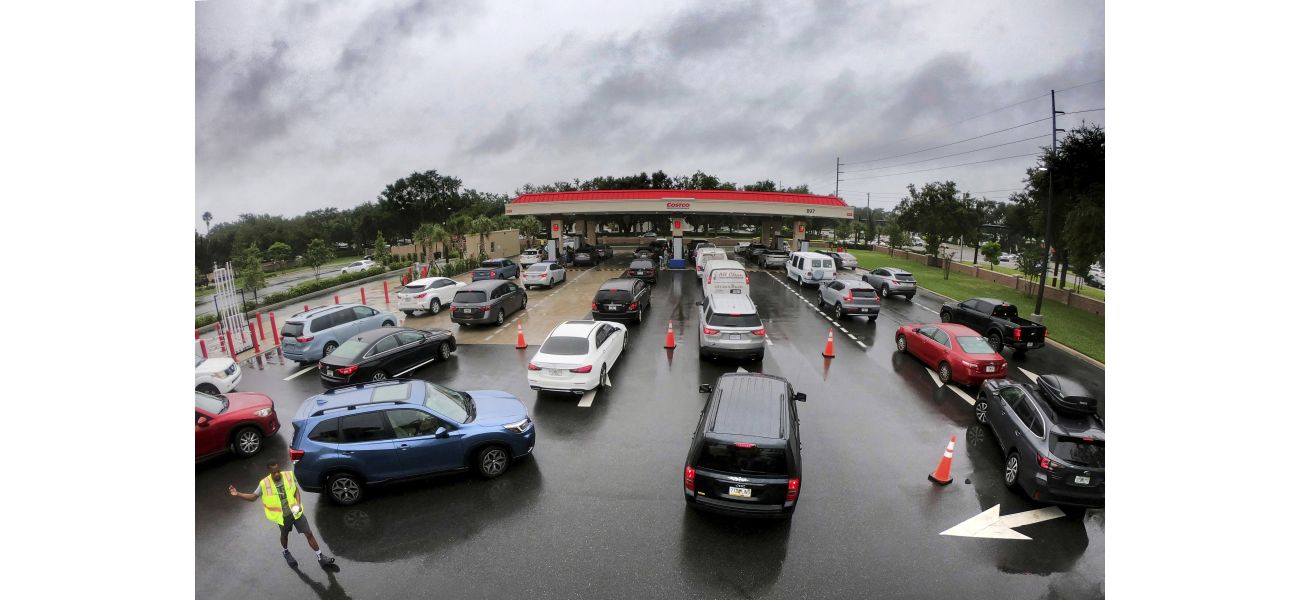Thousands flee as historic storm approaches America.
Hurricane Milton is now a Category 5 storm, heading straight for Florida.
October 7th 2024.

The news of Hurricane Milton's rapid strengthening and its trajectory towards Florida has everyone on edge. This fierce storm has now been classified as a Category 5 hurricane, and its expected direct hit on the densely populated Tampa area has officials and residents alike preparing for the worst. It's a situation eerily reminiscent of the destruction caused by Hurricane Helene just a couple of weeks ago.
Experts predict that the eye of the storm will make landfall in the Tampa Bay region on Wednesday, which hasn't seen a direct hit by a hurricane in over a hundred years. Although the system is expected to weaken slightly before reaching land, it is still forecasted to make landfall as a Category 3 or higher hurricane. As it moves inland, it is likely to maintain its hurricane strength, posing a potential threat to other states that were already devastated by Hurricane Helene.
Tampa Mayor Jane Castor expressed her concern for her city at a press conference, stating, "This is the real deal here with Milton. If you want to take on Mother Nature, she wins 100 per cent of the time." Florida Governor Ron DeSantis also emphasized the importance of clearing debris from Helene before Milton's arrival to prevent them from becoming dangerous projectiles.
Evacuation orders were issued in preparation for Milton's arrival, as forecasters warned of a possible storm surge of eight to 12 feet in Tampa Bay. They also cautioned about the potential for flash floods and river flooding, with estimates of five to 10 inches of rain in mainland Florida and the Keys, and possibly up to 15 inches in some areas. This is especially concerning considering the Tampa metro area's population of over 3.2 million people.
MIT meteorology professor Kerry Emanuel shared his concerns about Tampa's vulnerability, saying, "It's a huge population. It's very exposed, very inexperienced, and that's a losing proposition. I always thought Tampa would be the city to worry about most."
The hurricane and storm surge watches in Florida's west coast were expanded, and a hurricane watch was also issued for Florida's Lake Okeechobee, which is known for flooding during intense storms. Mexico's Yucatan state also prepared for the storm's impact.
The National Hurricane Centre reported that Milton, which intensified quickly on Monday, had maximum sustained winds of 160 miles per hour. The storm's centre was approximately 720 miles southwest of Tampa, moving east-southeast at a speed of nine miles per hour.
The Tampa Bay area is still recovering from the destruction caused by Helene and its powerful surge, which claimed the lives of 12 people. The worst damage was seen along a string of barrier islands from St. Petersburg to Clearwater.
In order to clear away the aftermath of Helene, more than 300 vehicles were deployed to gather debris on Sunday. However, they ran into a roadblock when they tried to drop off the debris at a landfill that was locked. State troopers had to use a rope tied to a pickup truck to break open the gates, as Governor DeSantis emphasized, "We don't have time for bureaucracy and red tape."
As preparations for Milton's arrival continued, lifeguards in Pinellas County removed beach chairs and other items that could become projectiles in the strong winds. Meanwhile, heaps of stoves, chairs, refrigerators, and kitchen tables waited to be picked up in other areas. Resident Sarah Steslicki expressed her frustration at the slow debris collection process, stating, "They've screwed around and haven't picked the debris up, and now they're scrambling to get it picked up. If this one does hit, it's going to be flying missiles. Stuff's going to be floating and flying in the air."
With the looming threat of Milton, Hillsborough County, where Tampa is located, ordered evacuations for areas adjacent to Tampa Bay and for all mobile and manufactured homes by Tuesday night. As the clock ticks down to Milton's arrival, everyone in its path is bracing for the worst and hoping for the best.
There's a lot of buzz going around about Hurricane Milton, and for good reason. It's quickly become a Category 5 hurricane, and it's headed straight for Florida. Specifically, it's on track to hit the Tampa area, which is densely populated and facing the possibility of a direct hit. This is especially concerning considering that this same area was recently hit by Hurricane Helene less than two weeks ago.
The storm is expected to make landfall on Wednesday in the Tampa Bay region, which hasn't experienced a hurricane head-on in over a century. While experts predict that it may weaken slightly before it reaches land, it's still projected to hit as a Category 3 or higher hurricane. Even as it moves across central Florida and towards the Atlantic Ocean, it's likely to maintain its hurricane strength. Thankfully, this means that other states, like those that were devastated by Helene, may be spared from the storm's wrath.
At a press conference, Tampa Mayor Jane Castor emphasized the gravity of the situation, stating, "This is the real deal here with Milton. If you want to take on Mother Nature, she wins 100 per cent of the time." Florida Governor Ron DeSantis also stressed the importance of clearing away debris left by Helene before Milton arrives, in order to prevent it from becoming dangerous projectiles.
As evacuation orders were issued, meteorologists warned of a possible storm surge of eight to 12 feet in Tampa Bay, as well as flash and river flooding due to heavy rainfall of five to 10 inches in mainland Florida and the Keys, with some areas receiving up to 15 inches. With a population of over 3.2 million people, the Tampa metro area is at high risk.
MIT meteorology professor Kerry Emanuel expressed concern for the area, saying, "It's a huge population. It's very exposed, very inexperienced, and that's a losing proposition. I always thought Tampa would be the city to worry about most." As a result, hurricane and storm surge watches were issued for much of Florida's west coast, and even Lake Okeechobee, which is known to flood during intense storms, is under a hurricane watch. Parts of Mexico's Yucatan state are also expected to be affected.
According to the National Hurricane Centre, Hurricane Milton intensified rapidly on Monday over the eastern Gulf of Mexico, with maximum sustained winds reaching 160 miles per hour. As of midday, the storm's centre was about 720 miles southwest of Tampa and moving east-southeast at nine miles per hour.
The Tampa Bay area is still recovering from the aftermath of Helene and its powerful surge, which claimed the lives of 12 people. The worst damage was seen along a series of barrier islands from St. Petersburg to Clearwater. In the rush to clean up the debris from Helene, more than 300 vehicles were collecting it on Sunday, but they ran into a roadblock when they arrived at a locked landfill gate. State troopers had to step in and break the lock with a pickup truck, as Governor DeSantis stated, "We don't have time for bureaucracy and red tape."
In preparation for Milton's potential impact, lifeguards in Pinellas County have already removed beach chairs and other items that could become dangerous in strong winds. Meanwhile, piles of furniture and appliances are waiting to be picked up in other areas. Sarah Steslicki, a resident of Belleair Beach, expressed frustration that debris hadn't been collected sooner, stating, "They've screwed around and haven't picked the debris up, and now they're scrambling to get it picked up. If this one does hit, it's going to be flying missiles. Stuff's going to be floating and flying in the air."
Hillsborough County, which includes Tampa, has ordered evacuations for areas near Tampa Bay and for all mobile and manufactured homes by Tuesday night. It's clear that everyone is taking Hurricane Milton very seriously, and for good reason. Mother Nature is not to be underestimated, and the safety of those in the storm's path is of the utmost importance.
Experts predict that the eye of the storm will make landfall in the Tampa Bay region on Wednesday, which hasn't seen a direct hit by a hurricane in over a hundred years. Although the system is expected to weaken slightly before reaching land, it is still forecasted to make landfall as a Category 3 or higher hurricane. As it moves inland, it is likely to maintain its hurricane strength, posing a potential threat to other states that were already devastated by Hurricane Helene.
Tampa Mayor Jane Castor expressed her concern for her city at a press conference, stating, "This is the real deal here with Milton. If you want to take on Mother Nature, she wins 100 per cent of the time." Florida Governor Ron DeSantis also emphasized the importance of clearing debris from Helene before Milton's arrival to prevent them from becoming dangerous projectiles.
Evacuation orders were issued in preparation for Milton's arrival, as forecasters warned of a possible storm surge of eight to 12 feet in Tampa Bay. They also cautioned about the potential for flash floods and river flooding, with estimates of five to 10 inches of rain in mainland Florida and the Keys, and possibly up to 15 inches in some areas. This is especially concerning considering the Tampa metro area's population of over 3.2 million people.
MIT meteorology professor Kerry Emanuel shared his concerns about Tampa's vulnerability, saying, "It's a huge population. It's very exposed, very inexperienced, and that's a losing proposition. I always thought Tampa would be the city to worry about most."
The hurricane and storm surge watches in Florida's west coast were expanded, and a hurricane watch was also issued for Florida's Lake Okeechobee, which is known for flooding during intense storms. Mexico's Yucatan state also prepared for the storm's impact.
The National Hurricane Centre reported that Milton, which intensified quickly on Monday, had maximum sustained winds of 160 miles per hour. The storm's centre was approximately 720 miles southwest of Tampa, moving east-southeast at a speed of nine miles per hour.
The Tampa Bay area is still recovering from the destruction caused by Helene and its powerful surge, which claimed the lives of 12 people. The worst damage was seen along a string of barrier islands from St. Petersburg to Clearwater.
In order to clear away the aftermath of Helene, more than 300 vehicles were deployed to gather debris on Sunday. However, they ran into a roadblock when they tried to drop off the debris at a landfill that was locked. State troopers had to use a rope tied to a pickup truck to break open the gates, as Governor DeSantis emphasized, "We don't have time for bureaucracy and red tape."
As preparations for Milton's arrival continued, lifeguards in Pinellas County removed beach chairs and other items that could become projectiles in the strong winds. Meanwhile, heaps of stoves, chairs, refrigerators, and kitchen tables waited to be picked up in other areas. Resident Sarah Steslicki expressed her frustration at the slow debris collection process, stating, "They've screwed around and haven't picked the debris up, and now they're scrambling to get it picked up. If this one does hit, it's going to be flying missiles. Stuff's going to be floating and flying in the air."
With the looming threat of Milton, Hillsborough County, where Tampa is located, ordered evacuations for areas adjacent to Tampa Bay and for all mobile and manufactured homes by Tuesday night. As the clock ticks down to Milton's arrival, everyone in its path is bracing for the worst and hoping for the best.
There's a lot of buzz going around about Hurricane Milton, and for good reason. It's quickly become a Category 5 hurricane, and it's headed straight for Florida. Specifically, it's on track to hit the Tampa area, which is densely populated and facing the possibility of a direct hit. This is especially concerning considering that this same area was recently hit by Hurricane Helene less than two weeks ago.
The storm is expected to make landfall on Wednesday in the Tampa Bay region, which hasn't experienced a hurricane head-on in over a century. While experts predict that it may weaken slightly before it reaches land, it's still projected to hit as a Category 3 or higher hurricane. Even as it moves across central Florida and towards the Atlantic Ocean, it's likely to maintain its hurricane strength. Thankfully, this means that other states, like those that were devastated by Helene, may be spared from the storm's wrath.
At a press conference, Tampa Mayor Jane Castor emphasized the gravity of the situation, stating, "This is the real deal here with Milton. If you want to take on Mother Nature, she wins 100 per cent of the time." Florida Governor Ron DeSantis also stressed the importance of clearing away debris left by Helene before Milton arrives, in order to prevent it from becoming dangerous projectiles.
As evacuation orders were issued, meteorologists warned of a possible storm surge of eight to 12 feet in Tampa Bay, as well as flash and river flooding due to heavy rainfall of five to 10 inches in mainland Florida and the Keys, with some areas receiving up to 15 inches. With a population of over 3.2 million people, the Tampa metro area is at high risk.
MIT meteorology professor Kerry Emanuel expressed concern for the area, saying, "It's a huge population. It's very exposed, very inexperienced, and that's a losing proposition. I always thought Tampa would be the city to worry about most." As a result, hurricane and storm surge watches were issued for much of Florida's west coast, and even Lake Okeechobee, which is known to flood during intense storms, is under a hurricane watch. Parts of Mexico's Yucatan state are also expected to be affected.
According to the National Hurricane Centre, Hurricane Milton intensified rapidly on Monday over the eastern Gulf of Mexico, with maximum sustained winds reaching 160 miles per hour. As of midday, the storm's centre was about 720 miles southwest of Tampa and moving east-southeast at nine miles per hour.
The Tampa Bay area is still recovering from the aftermath of Helene and its powerful surge, which claimed the lives of 12 people. The worst damage was seen along a series of barrier islands from St. Petersburg to Clearwater. In the rush to clean up the debris from Helene, more than 300 vehicles were collecting it on Sunday, but they ran into a roadblock when they arrived at a locked landfill gate. State troopers had to step in and break the lock with a pickup truck, as Governor DeSantis stated, "We don't have time for bureaucracy and red tape."
In preparation for Milton's potential impact, lifeguards in Pinellas County have already removed beach chairs and other items that could become dangerous in strong winds. Meanwhile, piles of furniture and appliances are waiting to be picked up in other areas. Sarah Steslicki, a resident of Belleair Beach, expressed frustration that debris hadn't been collected sooner, stating, "They've screwed around and haven't picked the debris up, and now they're scrambling to get it picked up. If this one does hit, it's going to be flying missiles. Stuff's going to be floating and flying in the air."
Hillsborough County, which includes Tampa, has ordered evacuations for areas near Tampa Bay and for all mobile and manufactured homes by Tuesday night. It's clear that everyone is taking Hurricane Milton very seriously, and for good reason. Mother Nature is not to be underestimated, and the safety of those in the storm's path is of the utmost importance.
[This article has been trending online recently and has been generated with AI. Your feed is customized.]
[Generative AI is experimental.]
0
0
Submit Comment





